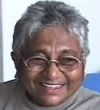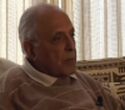Passive Resistance Campaign
Video Interviews
 "There were three people who had gone to jail for a month, and when they came back there were lots of celebrations..."
"There were three people who had gone to jail for a month, and when they came back there were lots of celebrations..." Video interview segment with Phyllis Naidoo [3:04]
May 6, 2006
 "That is when the [Indian] Congress called upon volunteers, and I, in my wisdom of 17 years, decided to volunteer and chucked off school ..."
"That is when the [Indian] Congress called upon volunteers, and I, in my wisdom of 17 years, decided to volunteer and chucked off school ..." Video interview segment with Ahmed Kathrada [3:07]
March 24, 2006
Audio Interviews
"There's meeting there... you must come, Aya. Everybody's going to jail, this country [is] fighting..."
Audio interview segment with Muniammah Naidoo [2:51]
June 25, 2002 Durban, South Africa.
Audio interview segment with Muniammah Naidoo [2:51]
June 25, 2002 Durban, South Africa.
Summary
The passive resistance campaign of 1946-48 was a powerful response to the Smuts government’s introduction of the Asiatic Land Tenure and Indian Representation Bill, which severely restricted the rights of Indians to own or occupy land. When Parliament enacted this bill, which Indian opponents referred to as “the Ghetto Act,” Indians pitched tents and occupied municipal land in Durban, the largest city in Natal, the part of South Africa with the largest Indian population. The first resisters were brutally beaten by a group of whites while police did nothing. After being arrested and released, many resisters returned to their “Resistance City.” The campaign ended in July 1948, after more than 2,000 men and women had been arrested. Indian opposition to the Ghetto Act remained strong, and its provisions for inadequate Indian political representation were not implemented.A few Africans, Coloureds, and whites participated in this campaign and were imprisoned along with Indians. The campaign laid the groundwork for cooperation between African and Indian organizations, particularly the Natal and Transvaal Indian Congresses and the African National Congress, which led to significant Indian support for the African miners strike in August 1946 and for the joint Defiance of Unjust Laws Campaign of 1952.
Related Multimedia Resources:
Web Documents
Journal Article: "Indian Passive Resistance Campaign in South Africa, 1946-48", Mainstream, New Delhi, April 5, 1997
By E.S. Reddy
[more info]
[Go to source directly and leave this site]
By E.S. Reddy
[more info]
[Go to source directly and leave this site]

Timeline: "South African History Timelines: 1946 Indian Passive Resistance"
[more info]
[Go to source directly and leave this site]
[more info]
[Go to source directly and leave this site]

Resource: "Gandhi and the Passive Resistance Campaign 1907-1914"
[more info]
[Go to source directly and leave this site]
[more info]
[Go to source directly and leave this site]



